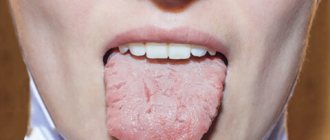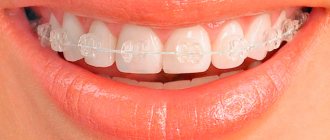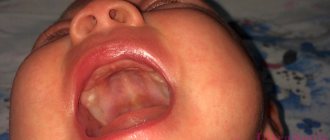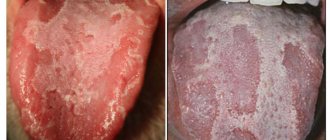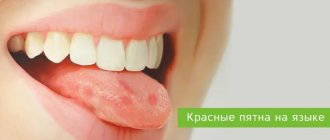Publication date: 01/27/2021
Just as poets consider the eyes to be the mirror of the soul, so doctors are accustomed to viewing the tongue as an organ that reflects the work of the body as a whole. No matter what you complain about, the doctor at the appointment will definitely ask you to stick out your tongue and carefully examine it. And at the dentist’s appointment, special attention will be paid to the tongue. And all because of glossitis. The word is beautiful, but the condition is not. Glossitis is an inflammation of the tongue, one of the signs of which is the appearance of cracks.
Tongue in cracks - reasons
- Bacterial and viral infections
This doesn't just apply to infections in the mouth. Viruses and bacteria spread throughout the body, and the infection manifests itself in the tongue. Most often, cracks in the tongue are caused by the herpes virus. - Anemia
Iron deficiency can cause glossitis. Iron is transported by a special protein - myoglobin, which is responsible for the healthy state of muscle tissue. If there is not enough iron, all muscles suffer, including the tongue. - Allergic reaction
The body's response to various allergens: food, medications, sometimes even toothpaste components - can cause inflammation. - Mouth injuries
Burns, cuts, and any mechanical injuries become an environment where bacteria multiply, which means inflammation occurs. - Vitamin deficiency
It has been scientifically proven that a deficiency of B vitamins can lead to cracked tongue.
Oral diseases (glossitis)
Glossitis is an inflammatory disease of the oral cavity that causes changes in the surface of the tongue. The tongue turns red and swells; A white coating, a burning sensation, and growths appear. There are more than 10 types of glossitis and only three of them are characterized by the appearance of cracks on the surface of the tongue.
Folded glossitis.
A congenital anomaly that is determined immediately after birth. Characterized by the presence of cracks of varying depths. Normally, they do not cause discomfort.
Diamond-shaped glossitis.
The affected area is diamond-shaped and has cracks in the middle of the tongue. Most often appears with gastritis with low acidity.
Desquamative glossitis.
It is sometimes called “geographical” because the lesions resemble the outlines of continents. Damaged areas can “move” on the surface of the tongue, almost always causing pain, burning, and shallow cracks. The reason for the appearance of such glossitis is still not clear. Some argue that this is an allergic reaction, others that it is a hormonal imbalance and gastrointestinal diseases.
Symptoms
Inflammation manifests itself in different ways, depending on the individual characteristics of the person and the underlying cause of the disease. Common symptoms include:
- Unpleasant sensations in the mouth
- Color change
- Pain
- Edema
- Burning or itching
- Surface change
- Changes in the size and shape of the papillae
- Cracks
- Difficulty swallowing
- Chewing problems
- Gray plaque
- Difficulty speaking
How do they look
Small cracks in the tongue can be completely invisible to the naked eye; only an experienced doctor can examine them using special instruments. The larger ones are clearly visible to the naked eye; they resemble longitudinal or transverse grooves on the tongue. Deep cracks look like crevices; sometimes the tongue appears to be cracked or split into two parts. If you notice such a problem, consult a doctor, even if nothing is bothering you at the moment. If an infection gets into the crack, the course of the disease may be complicated by the inflammatory process.
Treatment in the clinic
Before prescribing medications and procedures, it is necessary to find out why cracks occur. After this, a plan is drawn up, which may include:
- Treatment of a common disease
- Antifungal medications
- Iron tablets
- Vitamins
- Corticosteroids
- Immunostimulants
- Antihistamines
The surface of the tongue is disinfected with antiseptic solutions. Painkillers are used to reduce pain.
If mechanical injuries occur as a result of unsuccessful prosthetics, it is recommended to replace the structure.
Everyone has at least once encountered such an unpleasant phenomenon as the formation of a crack in the tongue. Moreover, very often it seems that the tongue has cracked for no apparent reason, on its own. Small cracks may not bother you at all for a long time, while deep cracks cause discomfort and acute pain to the patient. However, plaque and cracks should not be ignored, since over time even the smallest cracks, if left untreated, can increase in size and begin to hurt. We will tell you why they appear and what they mean, as well as whether congenital fissures are dangerous and how to treat them.
What it is
Officially, painful cracks on the tongue and along the edge of the tongue are called glossalgia. This is a fairly common neurosomatic disease.
Most common symptoms:
- dryness in the tongue area;
- itching and burning;
- swelling;
- soreness.
The insidiousness of glossalgia is that it does not go away on its own; without appropriate treatment it is impossible to get rid of a crack in the tongue.
At an early stage of the disease, the doctor may not notice pronounced cracks in the tongue, since they are microscopic and mainly manifest themselves as burning and pain. If you do not respond to this symptom in a timely manner, over time a crack may form at the tip or in the middle of the tongue, longitudinally, as well as cracks under the tongue and on the sides. In this case, the doctor also notes swelling and swelling of the tongue, atrophy of the salivary glands and filiform papillae on the surface of the tongue. The sooner you start treatment, the easier it is to get rid of glossalgia, so if you have cracks in your tongue, you should immediately consult a doctor.
Congenital fissures
It happens that a patient has cracks in the tongue since birth or childhood, which practically do not cause him any concern. Such cracks are usually transverse and are caused by the development and formation of the tongue.
Some patients have a so-called folded tongue, a congenital feature of tongue development. It is usually considered normal and does not require any treatment. The exception is red cracks in the tongue, which form at the bottom of the folds and cause pain to the patient. This happens with insufficient oral hygiene, so those with a folded tongue must carefully clean not only their teeth and gums, but also their tongue from plaque. If the owner of a folded tongue has developed cracks, treatment should be prescribed by a doctor, taking into account the design features of the patient’s tongue. To prevent the formation of folds in the depths, more attention should be paid to the sanitation of the oral cavity.
How do they look
Small cracks in the tongue can be completely invisible to the naked eye; only an experienced doctor can examine them using special instruments. The larger ones are clearly visible to the naked eye; they resemble longitudinal or transverse grooves on the tongue. Deep cracks look like crevices; sometimes the tongue appears to be cracked or split into two parts. If you notice such a problem, consult a doctor, even if nothing is bothering you at the moment. If an infection gets into the crack, the course of the disease may be complicated by the inflammatory process.
Reasons for appearance
Reasons for education:
- lack of nutrients, iron and vitamin PP in the patient’s body;
- anemia;
- lack of B vitamins;
- allergic reaction to toothpaste or medications;
- chronic fatigue and constant nervous tension;
- mechanical damage to the tongue (nervous biting, chewing);
- disruption of capillary blood flow in the tongue;
- the patient has diseases such as gastritis, enterocolitis, hepatitis, cholecystitis;
- wearing uncomfortable dentures.
The main reason why the tongue is cracked is mechanical injuries due to a lack of vitamins and microelements in the patient’s body. In this case, it is enough to bite your tongue while chewing food so that a painful crack forms at its tip.
Another fairly common reason why a patient’s tongue is cracked is a malfunction in the patient’s central nervous system, which is caused by chronic fatigue, frequent stress, and lack of sleep. This is a reason to suspect a problem with the hypothalamus.
It happens that patients are perplexed: why there are cracks on the tongue, there seems to be no visible reason for their appearance. In this case, the answer to the question of why cracks appear can only be given by an experienced doctor, after a thorough diagnosis. It is necessary to do a detailed blood test to determine which microelements and vitamins are missing in the patient’s body. Quite often, correction of the nutritional system helps get rid of the disease.
Many people are probably interested in the question of what cracks mean. After all, the tongue, as is known, signals the presence of many diseases and pathological conditions of the human body. Cracks in the tongue are a sign of a lack of vitamins and microelements in the body. Quite often, cracks are caused by worms, as they deplete the human body, causing anemia and iron deficiency. They also indicate a diseased liver, since with this disease the human body does not receive many microelements important for health.
Cracks in the tongue on the side can be a sign of thyroid disease; in this case, it swells and is injured at the edges by the patient’s teeth.
Treatment
The main question that worries patients with glossalgia is how to cure cracks in the tongue. In fact, everything is not so difficult. The treatment method depends on the cause of glossalgia.
- First, it is necessary to eliminate the dental causes of tongue cracks - correct an incorrect bite, replace defective fillings, repair a prosthesis. Next, the patient should be carefully examined by a therapist, neurologist, and, if necessary, by an endocrinologist and gastroenterologist. And only after this should treatment for glossalgia be prescribed.
- Typically, treatment for fissures consists of drug therapy and physiotherapeutic procedures. Treatment with medications is to improve blood circulation in the tissues of the oral cavity, as well as to improve general cerebral circulation. For this purpose, drugs such as trental, cavinton, nicotinic acid, and vitamin C are prescribed.
- The tone of the autonomic nervous system should also be improved; for this purpose, sedatives are prescribed - tincture of valerian, motherwort, persen.
- Additionally, the doctor may prescribe procedures such as electrical neurostimulation using a TENS device. A good effect is achieved by using electrophoresis, as well as iontophoresis of novocaine.
- If the tongue is severely painful, the doctor may prescribe local painkillers - lidocaine, dicaine.
- If the patient has cracks in the tongue, plaque and burning, it is necessary to adjust the diet. During treatment, you should completely exclude from the diet foods that irritate the surface of the tongue - such as sour juices, vegetables, pickles and marinades. You should not consume large amounts of spices, especially pepper and salt. It is advisable to quit smoking.
- After each meal, be sure to brush your teeth and rinse your mouth with salted water or a decoction of medicinal herbs. Oak bark, sage, propolis, and honey have a healing effect.
Home Remedies
Folk remedies are not able to eliminate the cause of cracks, especially if it is a common disease. In rare cases, the body can defeat a bacterial infection on its own. Therefore, medications from a home medicine cabinet can only be considered auxiliary. These include:
- Gargling with decoctions of sage and chamomile
- Lotions with sea buckthorn or olive oil
- Propolis
- Potato juice applications
Incorrectly selected folk remedies can reduce the effect of drug treatment.
Be sure to consult your doctor.
Diagnostics
Successful therapy requires careful research. Diagnostics in dentistry include an initial consultation with a dentist, and, if necessary, specialists. It is the dentist who deals with problems related to the oral cavity. Usually, after the dentist, the patient is sent to a therapist in order to study the clinical picture. Finding out the medical history allows you to determine which specialists to refer the patient to.
A loose tongue with cracks requires inspection:
- Hematologist;
- Gastroenterologist;
- Endocrinologist;
- Infectious disease specialist;
In addition, the patient is sent for blood tests, and a scraping of epithelial tissue in the area of the furrow is taken. The condition of the gastrointestinal tract is assessed, and other studies are carried out, which make it possible to assess the state of the body. All these examinations allow us to identify the true cause of the defect.
Top five dental clinics
All clinics on the list are multidisciplinary. They are engaged in prevention, treatment, prosthetics and implantation.
| Dental center | Clinic address | General information |
| Cerecon | Moscow, Andropova Ave. 8 | Metro Technopark. Opening hours: 24 hours a day |
| ROOT | Moscow, st. Rustaveli, 14 building 9 | Metro Butyrskaya. Opening hours from 10:00 to 22:00 |
| Alpha-Dent | Moscow, Beskudnikovsky blvd., 24, bldg. 1 | Metro Petrovskoye-Razumovskoye. Open all days of the week. |
| MegaStom | Moscow, Bolshoi Kozlovsky lane, building 10, building 2 | Metro Red Gate. They don't work on Sundays |
| Denta amo | Moscow, st. Grekova, 9 | Metro Medvedkovo Open daily from 9 to 9. |
What is glossitis?
Glossitis (from the Greek glossa (tongue) + suffix –itis) is an inflammation of the tongue. The reasons for its occurrence are different. Glossitis can develop as a result of a viral or bacterial infection, or as a result of another disease in the body. In addition, there are some other factors that provoke the development of the disease. These include mechanical, chemical and thermal damage to the oral cavity; nicotine; food that is too spicy or too hot; alcohol; caramel; some components present in toothpastes.
Glossitis has the following forms:
- folded
- diamond-shaped median
- desquamative
- hairy black
- Gunter's
- interstitial
According to the duration of the inflammatory process, acute and chronic glossitis are distinguished. The acute form of glossitis manifests itself as inflammation of the tongue, a change in its structure or color. Symptoms of the chronic form are more varied, but in most cases the disease is diagnosed by the presence or absence of papillomas - fungal growths on the tissues of the tongue. There are cases when the cause of the disease can be identified only after comprehensive medical research. True, this happens quite rarely and, as a rule, is associated with the presence of congenital, hereditary diseases.
Interstitial or sclerosing
Glossitis, shown in this photo, occurs in adults due to the presence of such a serious disease as syphilis. Symptoms: the affected muscles are gradually replaced by fibrous connective scar tissue, the papillae are completely smoothed out, painful cracks and trophic ulcers appear. The organ acquires tuberosity, because foci of inflammation grow unevenly. Externally it resembles a quilted blanket. The patient's tongue movement is difficult, swallowing and chewing functions are impaired, and speech is altered. And if treatment is not carried out in a timely manner, then there is a risk of oncological progression of the disease in areas of inflammation.
Candidiasis glossitis occurs with syphilis
Reasons for the development of pathology
Why a folded tongue occurs is not completely known. But in general, scientists and dentists are inclined to believe that the development of such a defect has three main reasons:
- genetic, that is, a congenital defect - why it occurs in this particular case is not known. Perhaps an intrauterine infection, perhaps heredity,
- as one of the symptoms of Melkersson-Rosenthal disease, in which swelling of the tongue, drying of the oral mucosa, swelling of the lips and parts of the face occurs. This disease is also characterized by neurosis of the facial nerves,
- glossitis, i.e. inflammatory process of the tongue. But in this case, swelling, soreness, enlarged lymph nodes and an increase in body temperature occur.
Lifestyle change
If a person’s tongue is covered with cracks, then it is necessary to exclude irritating factors when eating. This means that you need to remove hot, hot and spicy foods from your diet. It is necessary to limit the intake of store-bought and homemade marinades, sauces, and fried foods.
A balanced intake of vitamins A and B will help improve your general condition, which will have a beneficial effect on the speed of the process of getting rid of cracks. To provide the body with B vitamins and carotenes, you need to eat plant foods. Vitamin A and B12 are found in high concentrations in animal liver, dairy products and fish oil. In winter, if there is a shortage of vegetables and fruits that have not undergone deep heat treatment, it is necessary to take multivitamins.
Careful oral hygiene is required. It is better to clean teeth from plaque using a soft brush to avoid physical impact on the injured surface of the tongue, especially if it hurts.
Smoking is a significant problem because nicotine contributes to the development of stomatitis and gingivitis, diseases that often accompany glossitis . If your tongue is cracked, you should not drink strong alcohol, as it will cause burns to open wounds, which will take a long time to heal.
If a patient detects cracks in the tongue, doctors talk about a serious stage of glossitis, which must be treated urgently. In most cases, the treatment prognosis is favorable, and the technique depends on the causes of the disease, the neglect of the process and the presence of concomitant pathologies. The speed and effectiveness of therapeutic measures is directly related to how the patient complies with the recommendations of doctors.
Features of care
If you have this pathology, you do not need to self-medicate; careful care and supervision by a specialist are required. In general, you should take care of your oral cavity as follows:
- general oral hygiene;
- rinsing;
- if the patient uses removable dentures, they should also be thoroughly cleaned after eating;
- it is necessary to avoid spicy, salty food, it should not be too hot or cold;
- giving up bad habits (smoking, alcohol);
- You need to brush your teeth with a special paste;
- the toothbrush should be made of synthetic materials: this will help avoid damage;
- regular visits to the dentist.
Such careful care will help neutralize the oral cavity from bacteria, which will prevent their proliferation and the occurrence of associated infections.
Author:
Atrophic or pellagritic form
With this pathology, the inflamed tongue, as in the photo, does not significantly change its natural color, but it becomes very smooth, which is why it is easily confused with the Gunter variety. However, here the atrophy of the papillae is more pronounced; if left untreated, they decrease and may even completely disappear from the mucous membrane. In rare cases, a decrease in the muscle organ itself occurs.
The atrophic form is characterized by smoothness of the tongue
The disease is caused by an acute lack of vitamins in the body, as well as a lack of nicotinic acid.
Manifestations of tongue glossitis in children
In children, glossitis usually occurs at an early age - from 1 to 5 years. The causes of this pathological process have not yet been fully studied and can be very diverse: from infection to poor heredity. Externally, glossitis in children is manifested by the appearance of spots on the tongue, which slightly swells and itches. Itching and a burning sensation are the most unpleasant signs of glossitis, since a small child begins to scratch the tongue, thereby contributing to the appearance of microcracks with their subsequent infection. However, the disease does not pose a threat to the child’s life. The famous pediatrician Komarovsky does not recommend panicking about this and self-medicating by giving the baby serious medications. As a rule, multivitamins and a gentle regimen will have a positive effect within a week.
Allergic reactions
Did cracks appear on your tongue out of nowhere? Pay attention to your personal hygiene products; perhaps the reason is unsuitable toothpaste or mouth rinse. Or maybe you recently started taking medications that led to a similar reaction.
It will be enough to stop using the product and take a course of antihistamines so that the tongue in the cracks no longer bothers you. After such manipulations, the symptoms will naturally disappear.
“I really like to eat sour fruits, I love citrus fruits. There was a time when I couldn’t live a day without them. However, something bad happened to me; one morning I felt pain and a burning sensation on my tongue. Looking in the mirror, I saw that he also looked extremely unpleasant. The doctor said that this is an allergy to citrus fruits, that in principle you can’t eat a lot of them, and they are even dangerous for the mucous membranes.”
[email protected] , from correspondence on the forums
Folded tongue: photos and symptoms
Usually the anomaly is detected in early childhood, but it also occurs in adults, since sometimes this problem does not bother the patient in any way, and the person is not even aware of its presence. The signs of the disease are as follows:
- Macroglossia, or enlargement of the tongue, which can affect a person's speech and chewing function. Usually the patient keeps his teeth in an open position.
- Folds and grooves appear on the surface, which are covered with papillae.
- The tongue is significantly thickened.
- The back and tip of the tongue are smoothed, the filiform papillae have atrophied.
- Increased sensitivity (especially in people who have undergone infectious diseases and surgical operations).
- Regular tingling and pinching sensation.
- Lymph nodes are enlarged.
- Smell from the mouth.
The folds, in turn, are different: transverse, deep longitudinal (and not very deep), fringed. Usually the main longitudinal fold (it is the largest and deepest) runs from the tip along its midline. The remaining folds lead exactly to it.
Sometimes this pathology accompanies desquamative glossitis (geographic tongue) - this is inflammation, as a result of which some areas of the organ become several shades lighter or acquire a gray tint. In general, the picture of the organ resembles a map, which is why it got its name.
Which doctor should I contact?
The answer to the question of which doctor treats glossitis is simple. When painful changes appear in the mouth, patients turn to the dentist. This specialist will help alleviate the condition, but there is a high chance that damage to the taste organ is only a symptom of changes in the body. It is not always possible to determine the disease by the tongue; additional studies are prescribed. Consultations with a hematologist, endocrinologist and gastroenterologist may be required, diagnostics including:
- external examination of damage, swelling;
- epithelial scraping examination;
- blood analysis;
- identification of concomitant chronic or acute diseases.
